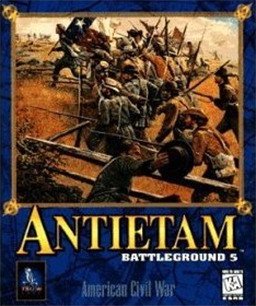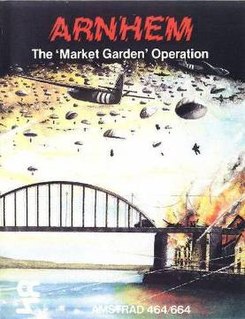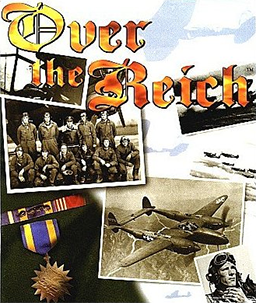Close Combat is the name of a series of real-time computer wargames by Atomic Games. In the Close Combat series, the player takes control of a small unit of troops and leads them in battles of World War II from a top down 2D perspective.
Real-time tactics (RTT) is a subgenre of tactical wargames played in real-time simulating the considerations and circumstances of operational warfare and military tactics. It is differentiated from real-time strategy gameplay by the lack of classic resource micromanagement and base or unit building, as well as the greater importance of individual units and a focus on complex battlefield tactics.

Fleet Command, previously labelled as Jane's Fleet Command, is a real-time tactics naval warfare simulation computer game released in May 1999. It was developed by Sonalysts Inc. and published by Electronic Arts (EA). The game licensed parts of Jane's Information Group's military information database, which was used as an in-game "Jane's Library", reference material that the player could refer to while in-game. Jane's also licensed to EA the "Jane's" name and the "Jane's Combat Simulations" logo, and the game was marketed under the "Jane's" name, much like the previous "Jane's Fighters Anthology", also published by Electronic Arts.

Battleground 4: Shiloh is a turn-based computer wargame developed by TalonSoft in 1996 and the fourth issue in the Battleground series.

Battleground 5: Antietam is a 1996 computer wargame developed by TalonSoft in 1996, the fifth issue in the popular Battleground series.
Storm Over Arnhem is a 1981 board wargame designed by Courtney F. Allen, published by the Avalon Hill game company, and depicts the battle for Arnhem bridge over the Lower Rhine river during Operation Market Garden in World War II. This battle was fought between elements of the British 1st Airborne Division and elements of the German Bocholt Battalion and 9th and 10th SS Panzer Divisions. The plan was for the airborne forces to seize and hold the Arnhem bridge for two days, before being relieved by the British XXX Corps. However, Operation Market Garden failed in numerous places, and the airborne troops were never relieved. They did however achieve more than their objective by capturing and holding the northern end of the Arnhem Bridge with some 700+ men for four days.

Grant, Lee, Sherman: Civil War Generals 2 is a computer game published by Sierra On-Line in 1997. It is the sequel to Robert E. Lee: Civil War General.

Robert E. Lee: Civil War General is a 1996 computer wargame developed by Impressions Games and published by Sierra On-Line. Set during the American Civil War, it tasks the player with leading the Confederate Army of Northern Virginia to victory against the Union Army of the Potomac. Impressions sought to make Civil War General accessible to wargame newcomers by streamlining its gameplay, and the Panzer General series was a reference point for its design and title.

Close Combat III: The Russian Front is a 1999 computer wargame developed by Atomic Games and published by Microsoft. It is the third game in the Close Combat series. It revolves around the Eastern Front during World War II, and takes players from the invasion of the Soviet Union to the final battle for Berlin in 1945.

People's General is a turn-based computer wargame developed by Strategic Simulations, Inc (SSI). It was released in September 1998 in North America and Europe. The game focuses on early 21st century warfare in Asia. People's General, or PeG as it is commonly known, followed SSI's successful 5 Star General Series of World War II war games and their sequel, Panzer General II (PG2). It uses the same game dynamics as these earlier games—turn-based movement & fighting with military units on a hex based map. PeG uses substantially the same "Living Battlefield" game engine as PG2 but features higher quality graphics and many new features.

Close Combat is a 1996 real-time computer wargame developed by Atomic Games and published by Microsoft. Set during World War II, it simulates the conflict between the United States' 29th Infantry Division and Germany's 352nd Infantry Division after the Invasion of Normandy. The player controls an artificially intelligent army whose behavior is dictated by psychological models: each soldier makes decisions based on the circumstances of the battlefield and can disobey the player's orders.

A computer wargame is a wargame played on a digital device. Descended from board wargaming, it simulates military conflict at the tactical, operational or strategic level. Computer wargames are both sold commercially for recreational use and, in some cases, used for military purposes.

Arnhem: The 'Market Garden' Operation is a battle strategy game by CCS. It was released for the ZX Spectrum and Amstrad CPC in 1985, the Amstrad PCW in 1987, the MS-DOS in 1988, and for the Amiga in 1991.

Over the Reich is a 1996 computer wargame for personal computers operating the Microsoft Windows operating system. The game was released in North America and Europe. A prequel, Achtung Spitfire!, was released in 1997.

Close Combat: Battle of the Bulge, sometimes known as Close Combat IV: Battle of the Bulge, is a 1999 computer wargame developed by Atomic Games and published by Strategic Simulations Inc. (SSI). A simulation of the Battle of the Bulge during World War II, it is the fourth game in the Close Combat series.
Panzer Campaigns is a series of operational level wargames developed by John Tiller Software and published until 2010 by HPS Simulations. There are currently twenty-six titles in the series, spanning the various fronts of World War II.
Battleground is a series of turn-based computer wargames developed and published by TalonSoft for Microsoft Windows between 1995 and 1999. Nine games were released in the series, each based on a different historical battle.

The Great Battles of Alexander is a 1997 turn-based computer wargame developed by Erudite Software and published by Interactive Magic. Adapted from the GMT Games physical wargame of the same name, it depicts 10 of Alexander the Great's key conflicts, and simulates the interplay between Ancient Macedonian battle tactics and its rival military doctrines. Gameplay occurs at the tactical level: players direct predetermined armies on discrete battlefields, in a manner that one commentator compared to chess.

Steel Panthers III: Brigade Command 1939–1999 is a 1997 computer wargame developed and published by Strategic Simulations, Inc. It is the third game in the Steel Panthers series, following Steel Panthers (1995) and Steel Panthers II: Modern Battles (1996). Like its predecessors, it was designed by Gary Grigsby and Keith Brors.

Battle of Britain is a 1999 computer wargame developed and published by TalonSoft. It was designed by Gary Grigsby and Keith Brors.















